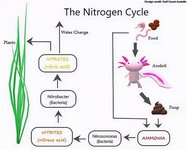I think you may be misunderstanding what nitrates are so let me give you a quick breakdown of the nitrogen cycle here:
Axolotls (and any aquatic species really) produce waste in the form of ammonia. In the presence of ammonia, nitrifying bacteria develops to convert that ammonia into nitrites. When nitrites are present, another type of nitrifying bacteria develops to break the nitrites down into nitrates. Therefore, you will never see nitrates in your tank without first introducing ammonia and allowing those bacteria colonies to develop. (ive also attached a little graphic I made for my website that may help with the visual)
As far as the health of your axolotl is concerned, the general rule is:
Ammonia = very bad/toxic
Nitrites = bad/toxic
Nitrates = still bad/toxic, just less so that the others.
The appearance of nitrates in your tank does nothing except indicate that you have nitrifying bacteria present to breakdown that waste, which is good, but that doesn't mean nitrates are good.
I'm not sure exactly what you've been doing to cycle your tank, but adding an ammonia source is your first step. Using plain liquid ammonia to dose your tank is a common way of doing that. Generally I dose new tanks to about 2ppm. You can then add starter bacteria if you would like to help speed up the process. Microbelift Special Blend is my personal preference, though I know a lot of people who use Dr. Tims One and Only. You'll want to test you tank every couple days to monitor for a rise in nitrites/drop in ammonia. You can then add a bit more ammonia to keep feeding that bacteria. You'll then start to see a rise in nitrates. Add more ammonia and bacteria. When the ammonia reading drops to zero, the nitrite drops to zero and the nitrate is at a measurable level, the aquarium is considered to be cycled. This process can take 4-6 weeks so be patient. Before you add any animals to the aquarium, do at least a 20% water change to lower the level of the nitrates. Different animals tolerate nitrates at different levels, but a safe rule of thumb is to keep your nitrate level below 40ppm. Typically, a 20 to 30% water change each week is enough to keep levels in a safe range, but this is also dependent on the size of your tank. A 20 gallon long tank is the minimum for an axolotl.
That should get your started. Let me know if you have any questions.

